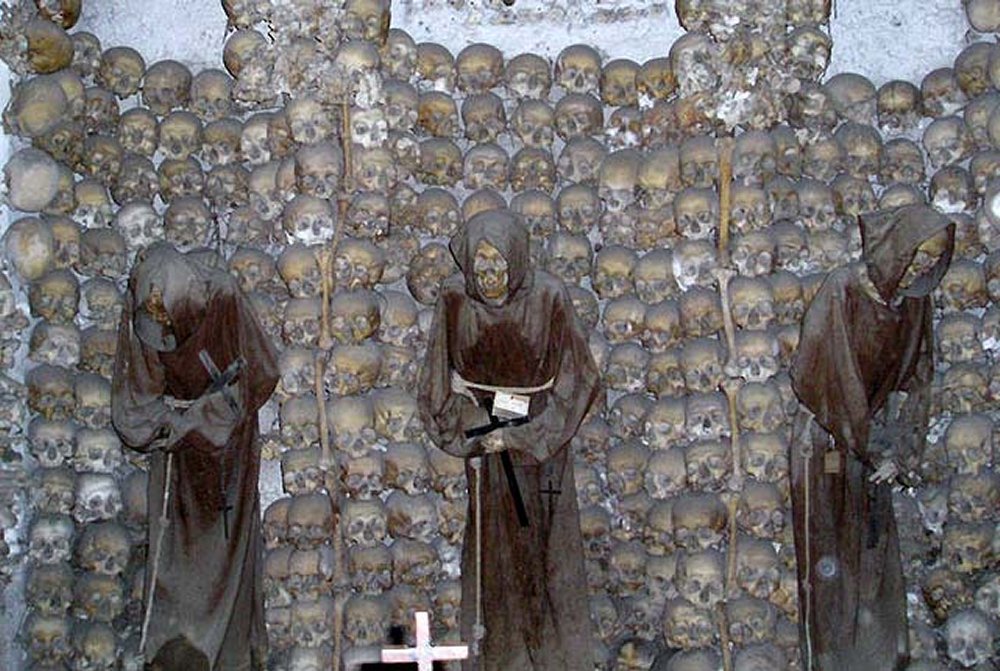Bizarre Ancient Capuchin Crypt ‘Decorated’ With The Bones Of 4,000 Monks
A. Sutherland - AncientPages.com - Under the city of Rome, there is a maze of long-forgotten ancient passages and temples; there are millennia-old underground burial chambers, which remember times when Christianity was only a forbidden cult and its members were executed as pagans and buried as martyrs.
One of the most original and eerie places in the underground realm of Rome is the Capuchin Crypt also known as the 'Bone Chapel'.
The Capuchin Crypt is a very special place with the remains of 4,000 Capuchin monks buried by their order. They ‘decorate’ the underground crypt with vertebrae chandeliers, skulls of real size and cross-bones.
Their standing and dressed in robes. Skeletons are staring from the walls and in the background, there are hundreds of anonymous skulls of those who died long ago.
The Capuchin Crypt with several small chapels is located beneath the church of Santa Maria della Concezione dei Cappuccini, in Rome, Italy and it comprises of six rooms filled with the bodies of friars who died between 1528 and 1870.
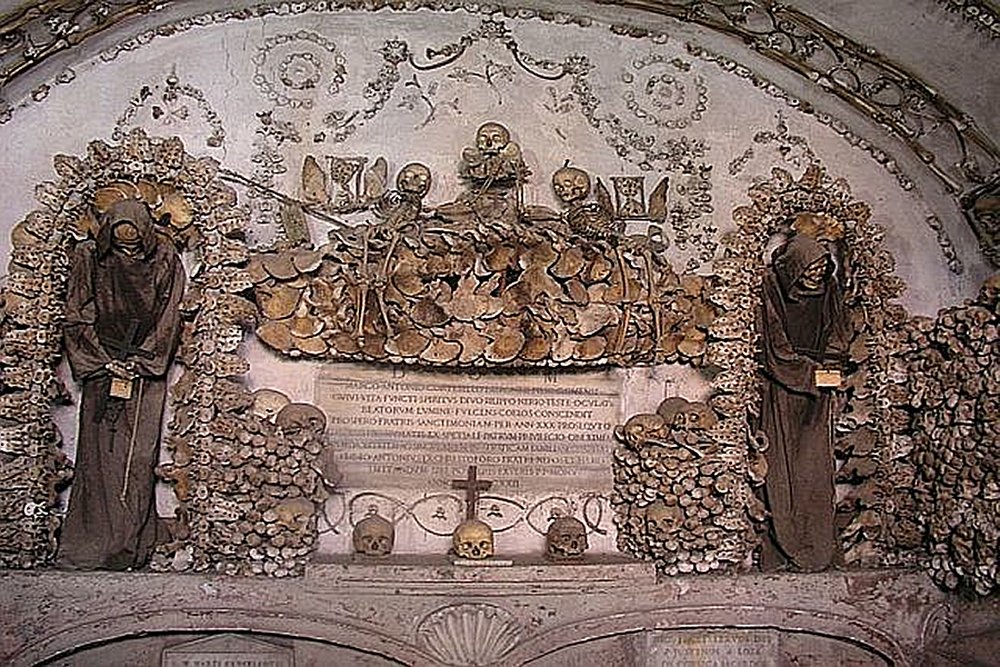
One of the most original and eerie place in the underground realm of Rome is the Capuchin Crypt also known as the 'Bone Chapel'. Image via wikipedia
On one of the chapel’s wall there is written in three languages,
"What you are now, we once were; what we are now, you shall be."
See also:
The Mystery Of Blinking Mummy Of Rosalia Lombardo
Paris Catacombs: Huge Underground Labyrinth Full Of Secrets
Secret Catacombs Contain Incredible Ancient Skeletons Covered In Priceless Jewelry
Znojmo Catacombs – Huge Underground Labyrinth Under A Medieval City
Probably it has never been an intention to display strange place and its atmosphere as a macabre, but rather to remind of the passage of time, which takes lives with it. Still the crypt is by many considered a morbid underground realm of death.
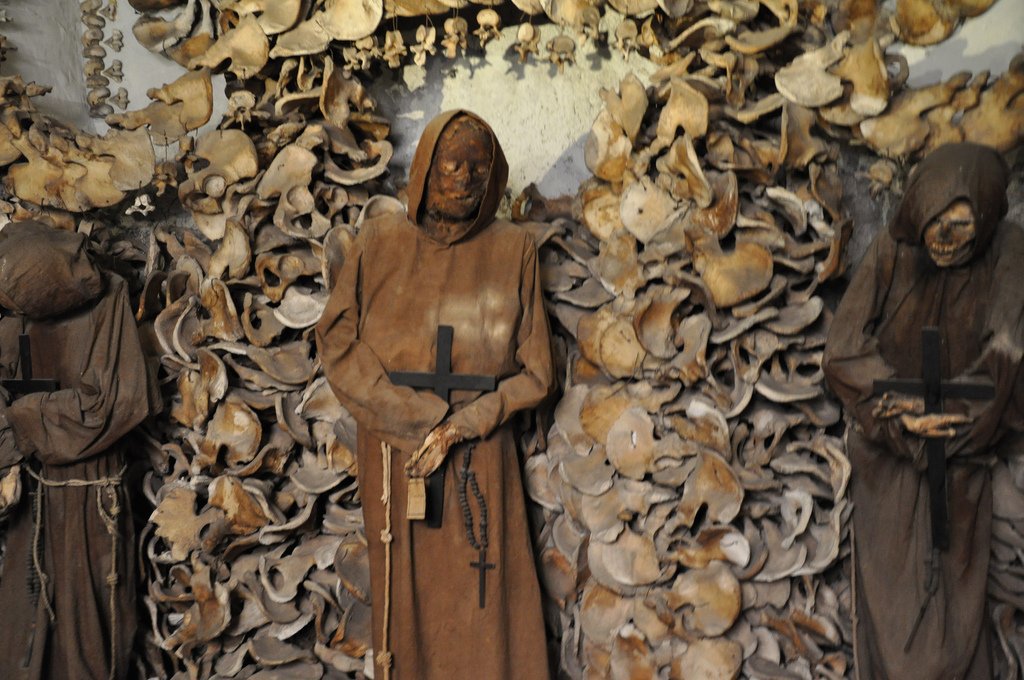
One of the most original and eerie place in the underground realm of Rome is the Capuchin Crypt also known as the 'Bone Chapel'. Image via wikipedia
Arthur B. Frommer, a travel writer, an author of a series of travel guides wrote about the crypt:
“one of the most horrifying images in all of Christendom”, large numbers of the bones are nailed to the walls in intricate patterns. Many are piled high among countless others, while others hang from the ceiling as light fixtures…”
When the monks arrived at the church in 1631, they brought 300 cartloads of deceased friars. Fr. Michael of Bergamo oversaw the arrangement of the bones in the burial crypt. The soil in the crypt was brought from Jerusalem, by order of Pope Urban VIII.
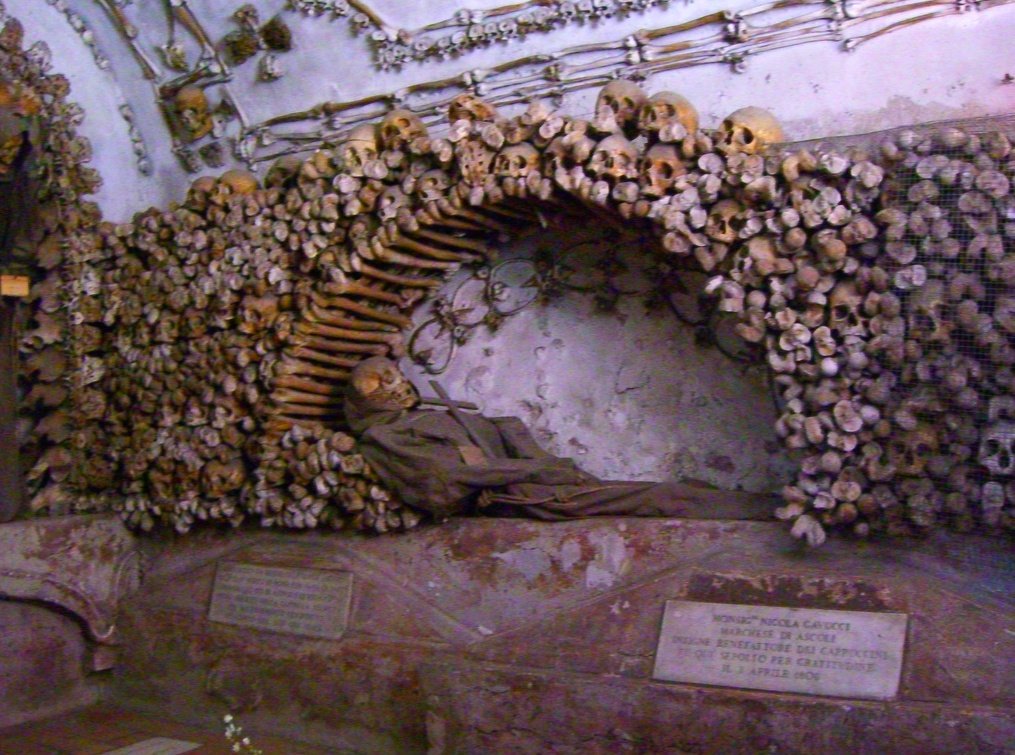
The skeletons, which are dressed in robes staring from the walls and in the background, there are hundreds of anonymous skulls of those who died long ago. Image via italianwriter.it
As monks died during the lifetime of the crypt, the longest-buried monk was exhumed to make room for the newly-deceased and so, it continued.
The newly-retrieved bones were immediately used as a ‘decoration’.
The dead monks’ bodies usually spent 30 years in the soil during the process of decomposition, before being exhumed.
The crypt had its beginnings in ancient times when a cult for a dead - rooted in Catholicism, but also closely associated with the cult of the dead of Greece and Rome – was flourishing.
Written by – A. Sutherland - AncientPages.com Senior Staff Writer
Copyright © AncientPages.com All rights reserved. This material may not be published, broadcast, rewritten or redistributed in whole or part without the express written permission of AncientPages.com
Expand for referencesMore From Ancient Pages
-
 Ancient Egyptian Knowledge Of The Cosmic Engine And Unseen God Of The Universe
Ancient Mysteries | Jan 15, 2019
Ancient Egyptian Knowledge Of The Cosmic Engine And Unseen God Of The Universe
Ancient Mysteries | Jan 15, 2019 -
 The Red Dragon Of Wales – Ancient Symbol Dating Back To Roman Times
Ancient Symbols | Jan 3, 2018
The Red Dragon Of Wales – Ancient Symbol Dating Back To Roman Times
Ancient Symbols | Jan 3, 2018 -
 Strange Ancient Human Bones And Artifacts Of An Unknown Lost Civilization Found In Nebraska
Featured Stories | Jun 20, 2024
Strange Ancient Human Bones And Artifacts Of An Unknown Lost Civilization Found In Nebraska
Featured Stories | Jun 20, 2024 -
 Joseph Pujol – The Professional Farter Who Entertained People
Featured Stories | Jan 29, 2020
Joseph Pujol – The Professional Farter Who Entertained People
Featured Stories | Jan 29, 2020 -
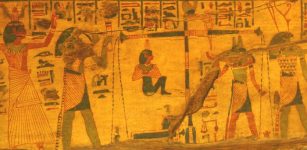 Meskhenet: Egyptian Goddess Of Household And Childbirth Who Governed Over Fate And Destiny
Egyptian Mythology | Mar 14, 2019
Meskhenet: Egyptian Goddess Of Household And Childbirth Who Governed Over Fate And Destiny
Egyptian Mythology | Mar 14, 2019 -
 Jiroft’s Konar Sandal – Home To A Huge Ziggurat And Many Ancient Treasures
Featured Stories | Jun 8, 2021
Jiroft’s Konar Sandal – Home To A Huge Ziggurat And Many Ancient Treasures
Featured Stories | Jun 8, 2021 -
 Feud Between The Medici And The Borgia Families – What Caused The Renaissance Clash?
Featured Stories | Mar 5, 2019
Feud Between The Medici And The Borgia Families – What Caused The Renaissance Clash?
Featured Stories | Mar 5, 2019 -
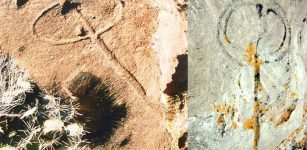 Puzzling Water Glyphs Of The American Southwest – Ancient Astronomical Symbols, Directional Signs Or Something Else?
Featured Stories | Apr 15, 2023
Puzzling Water Glyphs Of The American Southwest – Ancient Astronomical Symbols, Directional Signs Or Something Else?
Featured Stories | Apr 15, 2023 -
 Njord: Norse God Of The Seas And Seafarers And His Unhappy Marriage To Skadi
Featured Stories | Jul 10, 2018
Njord: Norse God Of The Seas And Seafarers And His Unhappy Marriage To Skadi
Featured Stories | Jul 10, 2018 -
 Nanna: Mesopotamian Moon God, Lord Of Wisdom And Father Of The Gods
Featured Stories | Apr 1, 2017
Nanna: Mesopotamian Moon God, Lord Of Wisdom And Father Of The Gods
Featured Stories | Apr 1, 2017 -
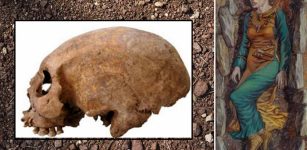 Unusual Viking Women With Elongated Heads On Gotland, Sweden
Featured Stories | Mar 28, 2024
Unusual Viking Women With Elongated Heads On Gotland, Sweden
Featured Stories | Mar 28, 2024 -
 ‘Bad King John’ Of England: His Lost Treasures Have Never Been Found
Featured Stories | Apr 6, 2016
‘Bad King John’ Of England: His Lost Treasures Have Never Been Found
Featured Stories | Apr 6, 2016 -
 The Writing Ball: A Great Invention In 1870
Ancient History Facts | Jun 30, 2016
The Writing Ball: A Great Invention In 1870
Ancient History Facts | Jun 30, 2016 -
 Goibniu: The Sword Smith Of Tuatha De Danann Who Forged Weapons For Battles In Celtic Mythology
Celtic Mythology | Jan 31, 2020
Goibniu: The Sword Smith Of Tuatha De Danann Who Forged Weapons For Battles In Celtic Mythology
Celtic Mythology | Jan 31, 2020 -
 10 Ancient Love Symbols
Featured Stories | Mar 2, 2023
10 Ancient Love Symbols
Featured Stories | Mar 2, 2023 -
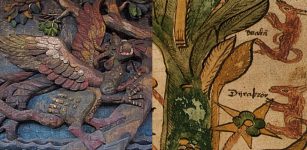 Magical And Malicious Creatures That Prey Upon Yggdrasil In Norse Beliefs
Featured Stories | Dec 6, 2019
Magical And Malicious Creatures That Prey Upon Yggdrasil In Norse Beliefs
Featured Stories | Dec 6, 2019 -
 Scientists Say Large Mammals Shaped The Evolution Of Humans – Here Is What Happened
Featured Stories | Jan 27, 2023
Scientists Say Large Mammals Shaped The Evolution Of Humans – Here Is What Happened
Featured Stories | Jan 27, 2023 -
 How Did St. Nicholas Become Santa Claus? – History, Legend And Tradition
Featured Stories | Dec 22, 2023
How Did St. Nicholas Become Santa Claus? – History, Legend And Tradition
Featured Stories | Dec 22, 2023 -
 Is Mysterious Prehistoric Jiroft The Legendary Land Of Aratta?
Featured Stories | Aug 20, 2015
Is Mysterious Prehistoric Jiroft The Legendary Land Of Aratta?
Featured Stories | Aug 20, 2015 -
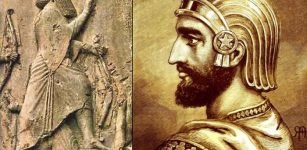 Murder Of Bardiya: Son Of Cyrus The Great And The Riddle Of The Impostor
Historical Figures | Dec 7, 2018
Murder Of Bardiya: Son Of Cyrus The Great And The Riddle Of The Impostor
Historical Figures | Dec 7, 2018

